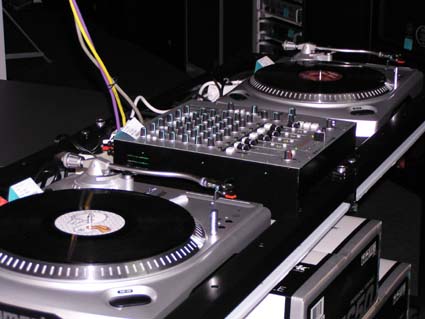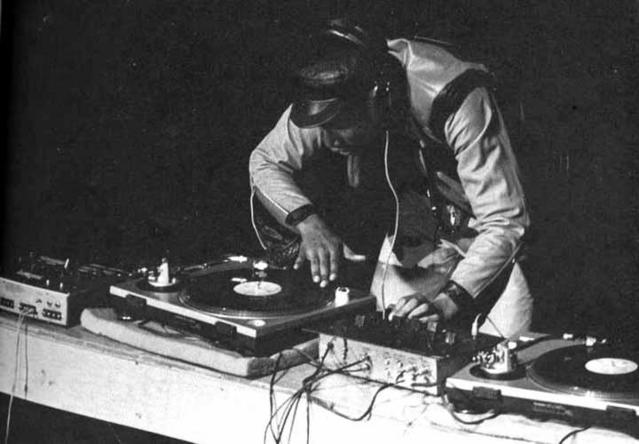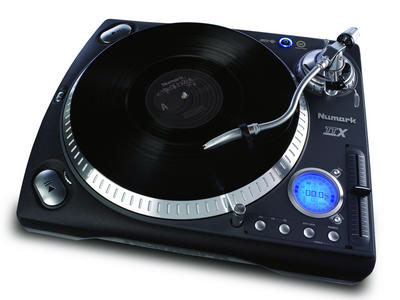Matt Shea is an occasional contributor to waycooljnr and a regular contributor to The Cool Hunter, Scene Magazine and a part-time copywriter for the man. He can be contacted at [email protected]
In the digital age of music, turntablism has remained a bastion of the analogue, a smoky backroom where arguments over white labels, pick-ups and the merits of the ‘S’-shaped tone arm are the order of the day. Now, with the rise and rise of the CD Deck and the laptop, the traditional turntable’s days may perhaps be numbered. With this in mind, Passion of the Weiss gets retrospective, thinking about hip-hop, turntablism and the best analogue turntable from each decade.
1970s – Technics SL-1200
The early days of hip-hop: steaming Bronx nights; bumping block parties; speaker stacks pulling their power through city lampposts. Herc with his sound system; Bam with his records; Flash with his technique. The
USERS & ABUSERS: Grand Master Flash, Afrika Bambaataa, DJ Kool Herc, Grand Wizard Theodore, DJ Breakout DJ Kool Herc.
There may be arguments over who invented hip-hop, but there is little denying that it was DJ Kool Herc who discovered the electricity of the breakbeat. Identifying strongly with the b-boys who would wait on the sidelines at his gigs until a song’s break came in, Herc began to experiment by playing just the breaks, one straight after another. His mixing technique may have been rudimentary, with Herc simply fading from one record to another whilst he talked over the transition, but seeing him through was his intimidating record collection and an outrageous speaker set, dubbed the Herculords. The crowds couldn’t get enough and the first spark of hip-hop was struck.
1980s – Technics SL-1200 MK II
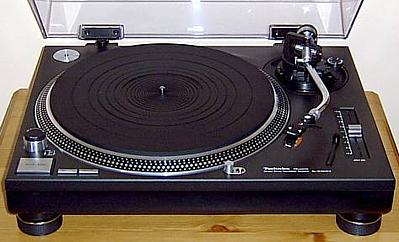
As the 70s drifted into the 80s, so too did hip-hop start to drift out of the Bronx, on to the island of Manhattan, and then beyond. It may have been the Sugar Hill Gang’s ‘Rapper’s Delight’ that started hip-hop’s exploration of the charts, but it was Grand Master Flash and the Furious Five’s ‘The Message’ that blew the door down, it’s stark and angry lyrics ticking the box of cultural significance that mainstream rock critics valued so highly.
This was the decade that the pioneers came into their own – Flash with ‘The Message’ and Bam with ‘Planet Rock’ – but it was also the decade that they passed the baton on to a second wave of hip-hop artists, whose continuing innovation helped secure a place for the genre in music’s mainstream. With uncanny timing, Technics helped facilitate hip-hop’s explosion in popularity, updating the SL-1200 in 1979 with the release of the SL-1200 Mk II.
The first dedicated deck for DJs, the Mk II is the dreadnought of turntables, seemingly indestructible in a physical sense whilst obliterating all comers function wise for the best part of two decades. Compared to its older sibling, the MK II brought with it significant improvements to the drive system, tone arm, and added a slider for greater pitch control. The SL-1200 Mk II was so good that competition was virtually nonexistent. The only entrants into the market simply peddled cheap imitations that excelled only in looking exactly like the Mk II. Just as hip-hop cemented its place in the musical mainstream, so too did Technics cement its position in the burgeoning culture, the SL-1200 Mk II becoming the professional DJ’s only weapon of choice for many years to come.
USERS AND ABUSERS: Grand Master Flash, Afrika Bambaataa, Grandmixer D.ST, Jam Master Jay, Jazzy Jeff, Eric B
Grand Master Flash:
Flash is fast, Flash is cool. Herc may have discovered the breakbeat, but it was Grandmaster Flash who took this peculiarity of the Bronx block party and turned it into a truly new form of new music. Flash was the technician of the turntable, inventing the Quick Mix theory and the Clock Theory. He was also extremely competitive, always chasing firsts, and when he witnessed ‘Rapper’s Delight’ race up the charts he was infuriated.
As the 80s kicked into gear and hip-hop exploded, Flash would have his revenge, not only with ‘The Message’ but also on ‘Adventures Of Grandmaster Flash On The Wheels Of Steel’ where he bamboozled listeners with seven minutes of hit-heavy quick mix electricity. Popular music’s horizons had just been expanded, and it was enough for Grand Master Flash to claim a place as perhaps the most important figure in the history of hip-hop.
1990s – Vestax PDX-A2s
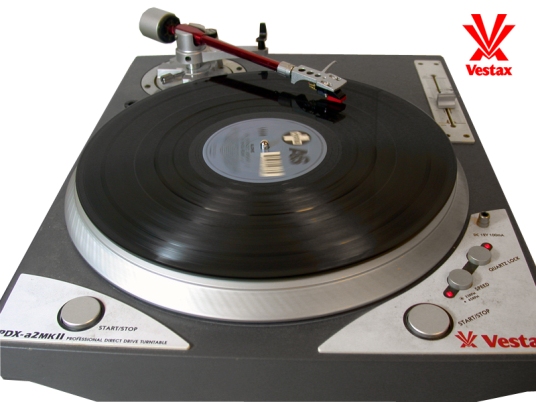
While the scratch was invented in the 1970s, it wasn’t until the 90s that something close to a subgenre was built around its manipulation. Hands that would dash from record to cross fader and back again; fingers moving with Swiss-precision while speakers rocked to a pounding beat: it was ultimately realised that the hip-hop DJ’s skills were visual and visceral enough to be pursued as an end in themselves and so turntablism was born.
As the 1990s had rolled on, the relentless march of gangster rap had virtually drained hip-hop of the original party spirit that had kick-started the genre. Turntablism was in part a reaction to this, sidestepping the MCs and building on the techniques of the founding fathers of hip-hop. In the hands of the skilled turntablist, the record deck was finally transformed into a genuine musical instrument. While hip-hop in the mainstream had ceased to evolve, so too had the turntable. Technics, so long the dominant force in the market, had neglected to update the SL-1200 Mk II and as turntablism applied it’s DJ-centric demands on the manufacturers, the Japanese kingpin was slow to innovate.
As turntablism shifted the paradigm for what was required from a record deck, so too did a batch of companies rise to challenge Technics’ domination. Stanton, Numark and Gemini all expanded their product range, but at the end of 90s when Technics were lambasted for their disappointing update to the SL-1200 line, it was Vestax who provided the starkest contrast and most compelling alternative, releasing their scratch-friendly PDX-A2s on to the market.
While turntablists had succeeded in turning the record player into a solo instrument, Vestax succeeded in providing these beat-swapping magicians with the first turntable designed to be played as an instrument. This led to a number of its key features, foremost among them being its vertical orientation, dual start/stop keys and an anti-skip straight tone arm, which allowed for non-slip performance during even the most intrepid incarnations of mixing technique. The perfect battle-ready deck, the PDX-A2s turned out to be just the beginning for Vestax and their turntables remain at the forefront of the Technics killers.
USERS AND ABUSERS The X-ecutuioners, Mixmaster Mike, Invisibl Skratch Piklz, Scratch Perverts, A-trak, Grandmaster Flash.
Mixmaster Mike: Of all the turntablists to emerge in the 1990s, none had quite the impact of Mixmaster Mike. Teaming up with Q-Bert to destroy the DMC World Titles three years running from 1992-1994, Mixmaster Mike went on to become The Beastie Boy’s resident DJ. Mike’s audacious digit athleticism enthralled the Beastie’s audiences; the DJ was being noticed again and suddenly a whole new generation of fans was hooked on turntablism.
2000s – NUMARK TTX
As the new decade began, hip-hop also moved into a new era with the genre’s breadth increasing dramatically. While hip-hop culture continued to move further into the mainstream, turntablism, at one point in danger of becoming an esoteric footnote in the genre’s history, was saved by an ever-increasing hunger for the ‘old school,’ to which the tuntablists were scene as a direct link.
The turntablist DJ, by taking some of the spotlight away from the MC, was reminding fans of their hip-hop history and preserving the music’s roots in the process. As the DJ began to receive more exposure in a genre that was picking up a whole new generation of followers, so too did the turntable and the manufacturers move further into the spotlight. The innovation that had started in the 90s exploded in the new millennium. Vestax switched back to a conventional horizontal layout for it’s PDX-2000/2300 decks, which were laden with features and equipped with callus-cutting amounts of torque while
USERS AND ABUSERS: Roc Raida, DJ Logic, Birdy, Nam Nam, Lil’ Mike DJ Logic:
As turntablism entered it’s second decade of existence, few have taken the art in such an interesting direction as DJ Logic. Logic’s work takes the almost scientific nature of turntablism and runs it through with the improvisational spirit of jazz. Indeed, Logic took the concept of the turntable as an instrument and introduced it to the jazz bandstand.
His approach produces music that is at the same time both experimental and infectious, without ever feeling dichotomous. Logic manages to flesh-out fully fledged pieces of jazz around the scratches and scribbles from his record deck and the result is a new take on turntablism that pushes the boundaries of hip-hop even further.
Download:
MP3: Grandmaster Flash-“The Adventures of Grandmaster Flash” (Left-Click)

